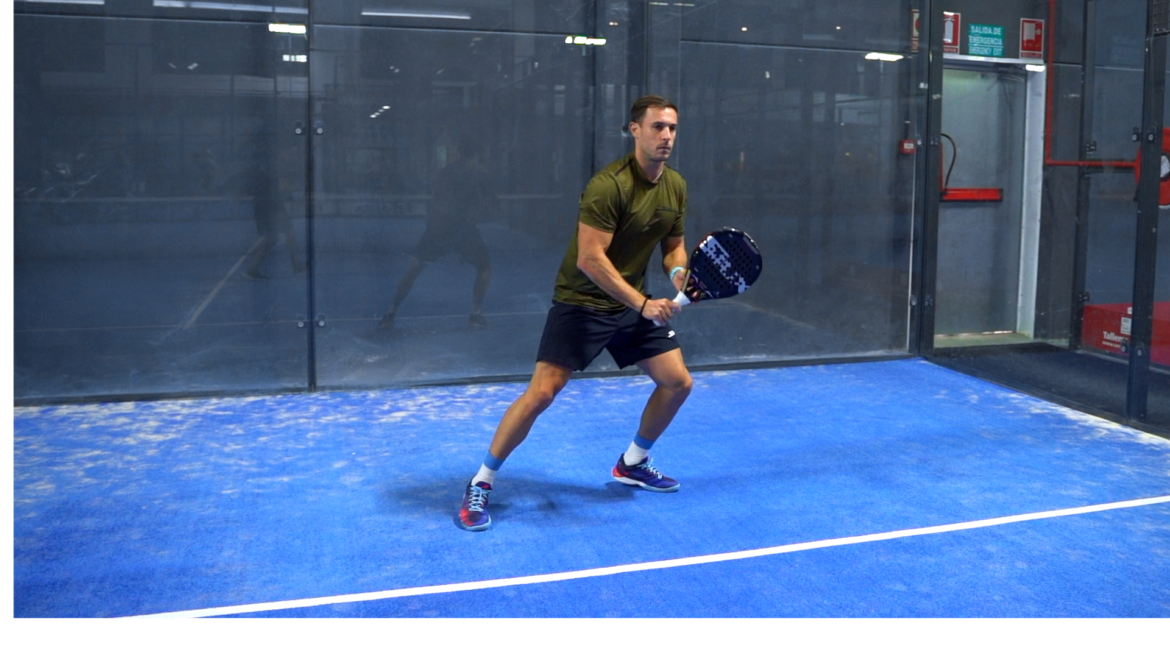What is a change of direction?
In this article we will talk about the change of direction in padel, also called CDD.
I will try to land this concept in a way that is very easy for you to understand, for this I will put some of the most characteristic situations that occur during the game and that surely have happened to you at some point.
It is very likely that you feel identified in many of these actions, and after reading this short article you will know better what is happening, why and how you can improve it.
A CDD occurs when you have to chain two balls in two different spots on the court when the opponent responds to your first stroke.
This is naturally a very common occurrence when you play.
In this action there is a characteristic movement that allows you to change the orientation of your body, and this is therefore the context on which a CDD is based.
At this impasse, there are several supports that mark the change of direction.
Therefore, we have here the first key point of this movement mechanics. It is not just one support, but several: the ones before, the support that allows you to turn and the ones that follow after the change of direction.
Game situations where there is CDD
Let’s identify some of the most common actions that occur in your matches and force you to make a change of direction.
- You returning: they serve to the “T” and then play a shorter ball to the fence.
- You are at the net: they hit a down the wall down the middle of the court and after blocking it with the volley they play you a parallel.
- You are at the back of the court: they play you to the side wall and then to the centre of the court.
- You are defending at the back court: you are played a deep ball to the corner and then a drop shot.
- You are protecting the net after a lob: you play a lob, you are overtaken in the middle and must turn to answer the ball after the backhand return.
By now, and I am sure that before reading these points, you already knew what a CDD was. There are a thousand examples, but with the previous ones we have surely landed on the possible game situations that can make you make a CDD. You can guess that there are a multitude of situations where very distinctive CDDs are made. Here is the second key point of this article, changes of direction are an inevitable constant in padel, if or if you are going to have to make more than one, if not in every point, at least in every game.
These changes of direction have the main function of braking and going in a different direction to the one you were going due to inertia. Here is the third key point, whenever you make a change of direction there will be a certain inertia (force that you carry by weight and momentum) and therefore you will have to cancel this inertia to change your orientation. The more inertia you carry, the more you will have to counteract this force to brake and go the other way.
This mechanic will therefore make you either a slow player or a fast player.
When do you reveal that you are a slow CDD player in padel?
- When you are stuck on the carpet and off balance.
- When you find it hard to get out for a ball that is heading in the opposite direction to where it was going.
- When you need to take a lot of steps to stop and the ball is already coming back.
- When you feel like your head wants to go for that ball but your legs are still going for it.
- When there are certain balls that you know are very difficult to return and they keep coming back in your matches.
- When you see it passing close to you but not close enough to hit it.
Many, if not all, of these situations are often caused by a lack of speed in the CDD.
Here the fourth key point, speed is one of the indispensable ingredients of CDD.
But as you already know and as we have said before, before doing something at high speed, you should first control it at low speed. And that brings us to technique. The fifth essential key point of this mechanic is to know how to do it well.
How is a change of direction done technically well?
To do it well, you must first of all master your body. That is, your body should not be a burden, but on the contrary, your body should be the machine that helps you to play better, not to slow you down.
Therefore, for a good technique you have to know how to use your body, from a technical and coordination point of view.
On the other hand, we have timing, something that is sometimes neglected or overlooked. Timing is the sixth and last key point of this article and it is nothing more than the fruit of experience, intuition and the reading we make of the game, the opponent and the ball.
With good timing one changes direction better, one dances better with the ball and everything flows better.
If you feel that with the necessary steps you are on the right track, if you feel that you are running all the time and you are still late to the balls, something is wrong. It should be reviewed and improved.
TIPS for the key points of the change of direction
I am going to give you some useful tips, here is an important tip for each of the key points of CDD.
Key point no. 1: understand it more openly.
It is not just one support, but several. The ones before, the one you turn and the ones after. You will be braking with very important muscles such as the quadriceps and femorals, which will also work to propel you. They will help and co-activate each other to alternate their function in braking and acceleration.
Key point number 2: get familiar with them.
Changes of direction are an inevitable constant in padel, if not in every point, at least in every game. Use them more often by doing padel-specific physical preparation, use them better, adapt them to the real demands of padel, strengthen them specifically for these actions.
Key point nº 3: control inertia.
Whenever you make a change of direction there will be some inertia (force you carry by weight and momentum) and therefore you will have to cancel this inertia to change your orientation. The more inertia, the more you have to counteract this force. Get used to managing your central axis better, use the racket to counterbalance weights and push yourself with it, don’t let it get in your way. Learn to brake better, faster, in less time and without needing so many metres. The third-to-last and second-to-last steps will be key to this.
Key point no. 4 be fast.
Speed is one of the essential ingredients of the CDD. Do high-speed exercises that help you optimise the nervous system and contract muscle fibres quickly. The reactivity of your tendons will also be crucial.
Key point no. 5: technical and coordinative mastery.
To do it well, you must first of all master your body. To do this, you must be more efficient in your footwork, apply your strength better to brake and then accelerate. Use your joints well, avoid destabilising your knee, use your glutes, lower your centre of gravity. The kicking foot is vital to get off the ground and use your big toe to apply force against the carpet. You need a flexible and strong big toe.
Key point no. 6: timing.
The result of experience, intuition and our reading of the game, the opponent, and the ball. Change direction fluidly, in time and premeditating a possible anticipation of where the next shot is likely to go. Dance with the ball.
Other key points:
There are many other aspects that you should start to master in order to improve your movements on the court:
- Stable ankles
- General and segmental coordination
- Body orientation.
- Motor reaction.
- Rhythm.
- Sprinting technique.
- Bilateral deficits
- Muscle reactivity
- Stability of the three key links: ankle, knee and hip.
- Involvement of the gluteus medius in pivot stability
- The role of the adductors in braking.
- The mobility of the hip.
- The use of the trunk and arms for rotations.
- Controlling efficient angles to generate power.
And an endless number of details that make this not easy to simplify, even so, I hope I have achieved it in some way, and that it helps you to understand what you need, what things you should focus on and where you should direct your physical work to improve your game in this mechanical aspect so frequent in all your matches.
I hope you liked it and see you in the next article.


